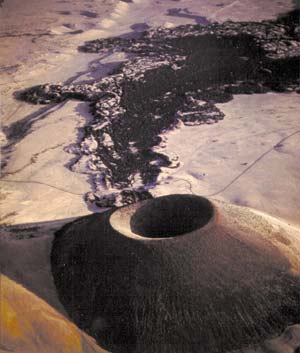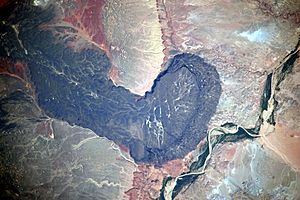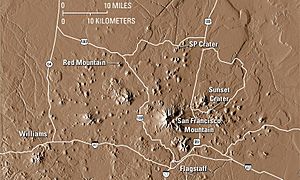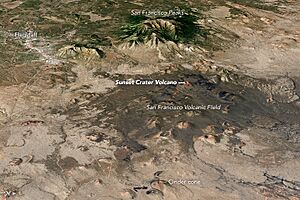San Francisco volcanic field facts for kids
The San Francisco volcanic field is a huge area in northern Arizona, USA, filled with many volcanoes. It is located north of Flagstaff and covers about 1,800 square miles (4,700 km²). This area is part of the southern edge of the Colorado Plateau.
There are about 600 volcanoes here! Some are nearly 6 million years old, while others are less than 1,000 years old. The youngest volcano in this field is Sunset Crater. The tallest point in the field is Humphreys Peak, which is Arizona's highest mountain. It stands at 12,633 feet (3,851 m) tall and is part of the San Francisco Peaks. These peaks are actually an old, inactive stratovolcano complex.
Contents
How the Volcanoes Formed
This volcanic area likely formed because of a geological hotspot deep under the Earth. Imagine a hot spot that stays in one place while the land above it moves. As the North American Plate (the huge piece of Earth's crust we live on) slowly moves over this hotspot, new volcanoes pop up.
Because of this movement, the newest volcanoes are found on the eastern side of the field. Most of the volcanoes here are cinder cones made of basalt rock. But there are also larger lava domes made of different types of rock called rhyolite and dacite.
Will There Be More Eruptions?
Since Sunset Crater is so young (less than 1,000 years old), it means volcanoes in this area can still erupt. Eruptions have happened every few thousand years in the past. So, it is possible that a new eruption could happen in the San Francisco Volcanic field someday.
However, it is impossible to know exactly when or where a new eruption might occur. Experts from the United States Geological Survey (USGS) think that if an eruption happens, it would likely be on the eastern side of the field. This is where the most recent volcanic activity has been. They also believe any future eruption would probably be small and not cause much danger, as the area is quite remote.
Visiting the Volcanic Field
The San Francisco volcanic field is a popular place for tourists and hikers. One well-known spot is the Kendrick Mountain Wilderness, which is about 20 miles northwest of Flagstaff.
Sunset Crater is another very popular place to visit. It is easy to get to and has interesting lava flows at its base. It's a great place to see what a relatively new volcano looks like!
NASA's Use of the Area
Did you know that NASA has used parts of this volcanic field for special tests? They use the area to practice techniques for exploring other planets, like Mars. It's a bit like a natural space training ground! NASA has also done tests here called the Desert Research and Technology Studies (DRATS).
Some Famous Volcanoes Here


Here is a list of some of the notable volcanoes and peaks in the San Francisco volcanic field:
| Name | Height | Location | Last known eruption | |
| meters | feet | Coordinates | ||
| Bill Williams Mountain | 2,821 | 9,256 | - | 2.8 million years ago |
| Colton Crater (Crater 160) | 2,246 | 7,368 | 35°32′42″N 111°38′10″W / 35.54500°N 111.63611°W | - |
| Double Crater | 2,426 | 7,959 | 35°20′44″N 111°27′5″W / 35.34556°N 111.45139°W | - |
| Kendrick Peak | 3,175 | 10,418 | - | 1.4 million years ago |
| Merriam Crater | 2,077 | 6,813 | 35°20′19″N 111°17′11″W / 35.33861°N 111.28639°W | 20,000 years ago |
| Mount Elden | 2,835 | 9,300 | 35°20′47″N 111°40′40″W / 35.34639°N 111.67778°W | - |
| O'Leary Peak | 2,718 | 8,916 | 35°24′05″N 111°31′36″W / 35.40139°N 111.52667°W | Pleistocene |
| San Francisco Peaks | 3,851 | 12,633 | 35°20′47″N 111°40′40″W / 35.34639°N 111.67778°W | - |
| Sitgreaves Mountain | - | - | - | 1.9 million years ago |
| SP Crater (SP Mountain) | 2,140 | 7,021 | 35°34′56″N 111°37′55″W / 35.58222°N 111.63194°W | 71,000 years ago |
| Strawberry Crater | 35°26′38″N 111°28′40″W / 35.44389°N 111.47778°W | - | ||
| Sunset Crater | 2,446 | 8,026 | 35°21′51″N 111°30′11″W / 35.36417°N 111.50306°W | 950 ± 40 years ago |
| Sugarloaf Peak | - | - | - | 220,000 years ago |



